
Computer port
In computer hardware, a port serves as an interface between the computer and other computers or peripheral devices. In computer terms, a port generally refers to the female part of connection. Computer ports have many uses, to connect a monitor, webcam, speakers, or other peripheral devices. On the physical layer, a computer port is a specialized outlet on a piece of equipment to which a plug or cable connects. Electronically, the several conductors where the port and cable contacts connect, provide a method to transfer signals between devices.
Physical shapes
Port connectors may be male or female, but female connectors are much more common. Bent pins are easier to replace on a cable than on a connector attached to a computer, so it was common to use female connectors for the fixed side of an interface.
Computer ports in common use cover a wide variety of shapes such as round (PS/2, etc.), rectangular (FireWire, etc.), square (Telephone plug), trapezoidal (D-Sub — the old printer port was a DB-25), etc. There is some standardization to physical properties and function. For instance, most computers have a keyboard port (currently a Universal Serial Bus USB-like outlet referred to as USB Port), into which the keyboard is connected.
Physically identical connectors may be used for widely different standards, especially on older personal computer systems, or systems not generally designed according to the current Microsoft Windows compatibility guides. For example, a female 9-pin D-subminiature connector on the original IBM PC could have been used for monochrome video, color analog video (in two incompatible standards), a joystick interface, or for a MIDI musical instrument digital control interface. The original IBM PC also had two identical 5 pin DIN connectors, one used for the keyboard, the second for a cassette recorder interface; the two were not interchangeable. The smaller mini-DIN connector has been variously used for the keyboard and two different kinds of mouse; older Macintosh family computers used the mini-DIN for a serial port or for a keyboard connector with different standards than the IBM-descended systems.
Electrical signal transfer
Electronically, hardware ports can almost always be divided into two groups based on the signal transfer:
- Serial ports send and receive one bit at a time via a single wire pair (Ground and +/-).
- Parallel ports send multiple bits at the same time over several sets of wires.
After ports are connected, they typically require handshaking, where transfer type, transfer rate, and other necessary information is shared before data are sent.
Hot-swappable ports can be connected while equipment is running. Almost all ports on personal computers are hot-swappable.
Plug-and-play ports are designed so that the connected devices automatically start handshaking as soon as the hot-swapping is done. USB ports and FireWire ports are plug-and-play.
Auto-detect or auto-detection ports are usually plug-and-play, but they offer another type of convenience. An auto-detect port may automatically determine what kind of device has been attached, but it also determines what purpose the port itself should have. For example, some sound cards allow plugging in several different types ofaudio speakers; then a dialogue box pops up on the computer screen asking whether the speaker is left, right, front, or rear for surround sound installations. The user’s response determines the purpose of the port, which is physically a 1/8″ tip-ring-sleeve mini jack. Some auto-detect ports can even switch between input and output based on context.
As of 2006, manufacturers have nearly standardized colors associated with ports on personal computers, although there are no guarantees. The following is a short list:
- Orange, purple, or grey: Keyboard PS/2
- Green: Mouse PS/2
- Blue or magenta: Parallel printer DB-25
- Amber: Serial DB-25 or DB-9
- Pastel pink: Microphone 1/8″ stereo (TRS) minijack
- Pastel green: Speaker 1/8″ stereo (TRS) minijack
FireWire ports used with video equipment (among other devices) can be either 4-pin or 6-pin. The two extra conductors in the 6-pin connection carry electrical power. This is why a self-powered device such as a camcorder often connects with a cable that is 4-pins on the camera side and 6-pins on the computer side, the two power conductors simply being ignored. This is also why laptop computers usually have only 4-pin FireWire ports, as they cannot provide enough power to meet requirements for devices needing the power provided by 6-pin connections.
Optical (light) fiber, microwave, and other technologies (i.e., quantum) have different kinds of connections, as metal wires are not effective for signal transfers with these technologies. Optical connections are usually a polished glass or plastic interface, possibly with an oil that lessens refraction between the two interface surfaces. Microwaves are conducted through a pipe, which can be seen on a large scale by examining microwave towers with “funnels” on them leading to pipes.
Hardware port trunking (HPT) is a technology that allows multiple hardware ports to be combined into a single group, effectively creating a single connection with a higher bandwidth, sometimes referred to as a double-barrel approach. This technology also provides a higher degree of fault tolerance because a failure on one port may just mean a slow-down rather than a dropout. By contrast, in software port trunking (SPT), two agents (websites, channels, etc.) are bonded into one with the same effectiveness; i.e., ISDN B1 (64K) plus B2 (64K) equals data throughput of 128K.
Types of ports
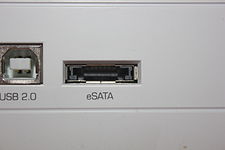
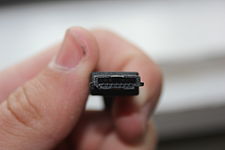
Serial ATA (SATA, abbreviated from Serial AT Attachment) is a computer bus interface that connects host bus adapters to mass storage devices such as hard disk drives, optical drives, and solid-state drives. Serial ATA succeeded the older Parallel ATA (PATA) standard, offering several advantages over the older interface: reduced cable size and cost (seven conductors instead of 40 or 80), native hot swapping, faster data transfer through higher signaling rates, and more efficient transfer through an (optional) I/O queuing protocol.
SATA host adapters and devices communicate via a high-speed serial cable over two pairs of conductors. In contrast, parallel ATA (the redesignation for the legacy ATA specifications) used a 16-bit wide data bus with many additional support and control signals, all operating at much lower frequency. To ensure backward compatibility with legacy ATA software and applications, SATA uses the same basic ATA and ATAPI command sets as legacy ATA devices.
SATA has replaced parallel ATA in consumer desktop and laptop computers, and has largely replaced PATA in new embedded applications. SATA’s market share in the desktop PC market was 99% in 2008. PATA remains widely used in industrial and embedded applications that use CompactFlash (CF) storage, which is designed around the legacy PATA standard, even though the new CFast standard is based on SATA.
Serial ATA industry compatibility specifications originate from the Serial ATA International Organization (SATA-IO). The SATA-IO group collaboratively creates, reviews, ratifies, and publishes the interoperability specifications, the test cases and plugfests. As with many other industry compatibility standards, the SATA content ownership is transferred to other industry bodies: primarily the INCITS T13 subcommittee ATA, the INCITS T10subcommittee (SCSI), a subgroup of T10 responsible for Serial Attached SCSI (SAS). The remainder of this article will try to use the terminology and specifications of SATA-IO.
eSATA
Standardized in 2004, eSATA (e standing for external) provides a variant of SATA meant for external connectivity. It uses a more robust connector, longer shielded cables, and stricter (but backward-compatible) electrical standards. The protocol and logical signaling (link/transport layers and above) are identical to internal SATA. The differences are:
- Minimum transmit amplitude increased: Range is 500–600 mV instead of 400–600 mV.
- Minimum receive amplitude decreased: Range is 240–600 mV instead of 325–600 mV.
- Maximum cable length increased to 2 metres (6.6 ft) (USB and FireWire allow longer distances.)
- The eSATA cable and connector is similar to the SATA 1.0a cable and connector, with these exceptions:
- The eSATA connector is mechanically different to prevent unshielded internal cables from being used externally. The eSATA connector discards the “L”-shaped key and changes the position and size of the guides.
- The eSATA insertion depth is deeper: 6.6 mm instead of 5 mm. The contact positions are also changed.
- The eSATA cable has an extra shield to reduce EMI to FCC and CE requirements. Internal cables do not need the extra shield to satisfy EMI requirements because they are inside a shielded case.
- The eSATA connector uses metal springs for shield contact and mechanical retention.
- The eSATA connector has a design-life of 5,000 matings; the ordinary SATA connector is only specified for 50.
Aimed at the consumer market, eSATA enters an external storage market served also by the USB and FireWire interfaces. The SATA interface has certain advantages. Most external hard-disk-drive cases with FireWire or USB interfaces use either PATA or SATA drives and “bridges” to translate between the drives’ interfaces and the enclosures’ external ports; this bridging incurs some inefficiency. Some single disks can transfer 157 MB/s during real use,about four times the maximum transfer rate of USB 2.0 or FireWire 400 (IEEE 1394a) and almost twice as fast as the maximum transfer rate of FireWire 800. The S3200FireWire 1394b spec reaches ~400 MB/s (3.2 Gbit/s), and USB 3.0 has a nominal speed of 5 Gbit/s. Some low-level drive features, such as S.M.A.R.T., may not operate through some USB or FireWire or USB+FireWire bridges; eSATA does not suffer from these issues provided that the controller manufacturer (and its drivers) presents eSATA drives as ATA devices, rather than as SCSI devices, as has been common with Silicon Image, JMicron, and NVIDIA nForce drivers for Windows Vista. In those cases SATA drives do not have low-level features accessible.
The eSATA version of SATA 6G operates at 6.0 Gbit/s (the term SATA III is being avoided by the SATA-IO organization to prevent confusion with SATA II 3.0 Gbit/s, which was colloquially referred to as “SATA 3G” [bps] or “SATA 300” [MB/s] since 1.5 Gbit/s SATA I and 1.5 Gbit/s SATA II were referred to as both “SATA 1.5G” [b/s] or “SATA 150” [MB/s]).
Therefore, eSATA connections operate with negligible differences between them. Once an interface can transfer data as fast as a drive can handle them, increasing the interface speed does not improve data transfer. Most newer computers, including netbooks/laptops, have external SATA (eSATA) connectors, in addition to USB 2.0 and sometimes USB 3.0 ports, though relatively few have built-in FireWire ports.
There are some disadvantages, however, to the eSATA interface:
- Devices built before the eSATA interface became popular lack external SATA connectors.
- For small form-factor devices (such as external 2.5-inch (64 mm) disks), a PC-hosted USB or FireWire link can usually supply sufficient power to operate the device. However, eSATA connectors cannot supply power, and require a power supply for the external device. The related eSATAp (but mechanically incompatible, sometimes called eSATA/USB) connector adds power to an external SATA connection, so that an additional power supply is not needed.
Desktop computers without a built-in eSATA interface can install an eSATA host bus adapter (HBA); if the motherboard supports SATA, an externally available eSATA connector can be added. Notebook computers can be upgraded with Cardbus or ExpressCard versions of an eSATA HBA. With passive adapters, the maximum cable length is reduced to 1 metre (3.3 ft) due to the absence of compliant eSATA signal-levels.
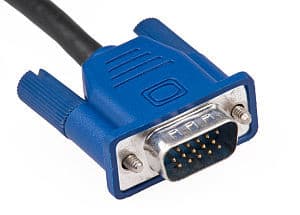
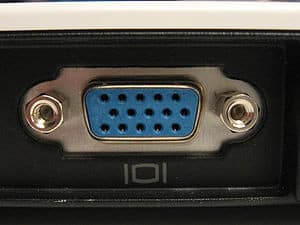
A Video Graphics Array (VGA) connector is a three-row 15-pin DE-15 connector. The 15-pin VGA connector is found on many video cards, computer monitors, and high definition television sets. On laptop computers or other small devices, a mini-VGA port is sometimes used in place of the full-sized VGA connector.
DE-15 has been conventionally referred to ambiguously as D-sub 15, incorrectly as DB-15 and often as HD-15 (High Density, to distinguish it from the older and less flexible DE-9 connector used on old VGA cards, which has the same E shell size but only two rows of pins).
VGA connectors and cables carry analog component RGBHV (red, green, blue, horizontal sync, vertical sync) video signals, and VESA Display Data Channel (VESA DDC) data. In the original version of DE-15 pinout, one pin was keyed by plugging the female connector hole; this prevented non-VGA 15 pin cables from being plugged into a VGA socket. Four pins carried Monitor ID bits which were rarely used; VESA DDC redefined some of these pins and replaced the key pin with +5 V DC power supply.
The VGA interface is not engineered to be hotpluggable (so that the user can connect or disconnect the output device while the host is running), although in practice this can be done and usually does not cause damage to the hardware or other problems. However, nothing in the design ensures that the ground pins make a connection first and break last, so hotplugging may introduce surges in signal lines which may or may not be adequately protected against. Also, depending on the hardware and software, detecting a monitor being connected might not work properly in all cases.


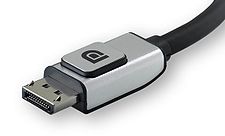
DisplayPort is a digital display interface developed by the Video Electronics Standards Association (VESA). The interface is primarily used to connect a video source to a display device such as a computer monitor, though it can also be used to carry audio, USB, and other forms of data.
VESA designed it to replace VGA, DVI, and FPD-Link. DisplayPort is backward compatible with VGA, DVI andHDMI through the use of passive and/or active adapters.

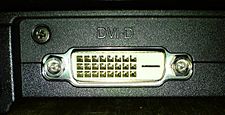

Digital Visual Interface (DVI) is a video display interface developed by the Digital Display Working Group(DDWG). The digital interface is used to connect a video source, such as a display controller to a display device, such as a computer monitor. It was developed with the intention of creating an industry standard for the transfer of digital video content.
The interface is designed to transmit uncompressed digital video and can be configured to support multiple modes such as DVI-D (digital only), DVI-A (analog only), or DVI-I (digital and analog). Featuring support for analog connections, the DVI specification is compatible with the VGA interface.This compatibility, along with other advantages, led to its widespread acceptance over competing digital display standards Plug and Display (P&D) and Digital Flat Panel (DFP). Although DVI is predominantly associated with computers, it is sometimes used in other consumer electronics such as television sets, video game consoles and DVD players.

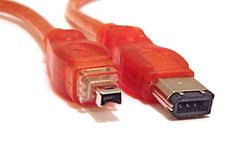
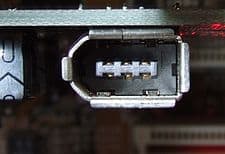
IEEE 1394 is an interface standard for a serial bus for high-speed communications and isochronous real-time data transfer. It was developed in the late 1980s and early 1990s by Apple, which called it FireWire. The 1394 interface is comparable to USB though USB has more market share. Apple first included FireWire in some of its 1999 Macintosh models, and most Apple Macintosh computers manufactured in the years 2000 – 2011 included FireWire ports. However, in 2011 Apple began replacing FireWire with the Thunderbolt interface and, as of 2014, FireWire has been replaced by Thunderbolt on new Macs. The 1394 interface is also known by the brand i.LINK (Sony), and Lynx (Texas Instruments). IEEE 1394 replaced parallel SCSI in many applications, because of lower implementation costs and a simplified, more adaptable cabling system. The 1394 standard also defines a backplane interface, though this is not as widely used.
IEEE 1394 was the High-Definition Audio-Video Network Alliance (HANA) standard connection interface for A/V (audio/visual) component communication and control. (HANA was dissolved in September 2009 and the 1394 Trade Association assumed control of all HANA-generated intellectual property.) FireWire is also available in wireless, fiber optic, and coaxial versions using the isochronous protocols.



The PS/2 connector is a 6-pin mini-DIN connector used for connecting some keyboards and mice to a PC compatible computer system. Its name comes from the IBM Personal System/2 series of personal computers, with which it was introduced in 1987. The PS/2 mouse connector generally replaced the older DE-9 RS-232 “serial mouse” connector, while the PS/2 keyboard connector replaced the larger 5-pin/180° DIN connector used in theIBM PC/AT design. The PS/2 designs on keyboard and mouse interfaces are electrically similar and employ the same communication protocol. However, a given system’s keyboard and mouse port may not be interchangeable since the two devices use a different set of commands.

In computing, a serial port is a serial communication interface through which information transfers in or out one bit at a time (in contrast to a parallel port).[1] Throughout most of the history of personal computers, data was transferred through serial ports to devices such as modems, terminals and various peripherals.
While such interfaces as Ethernet, FireWire, and USB all send data as a serial stream, the term “serial port” usually identifies hardware more or less compliant to the RS-232 standard, intended to interface with a modem or with a similar communication device.
Modern computers without serial ports may require serial-to-USB converters to allow compatibility with RS 232 serial devices. Serial ports are still used in applications such as industrial automation systems, scientific instruments, point of sale systems and some industrial and consumer products. Server computers may use a serial port as a control console for diagnostics. Network equipment (such as routers and switches) often use serial console for configuration. Serial ports are still used in these areas as they are simple, cheap and their console functions are highly standardized and widespread. A serial port requires very little supporting software from the host system.
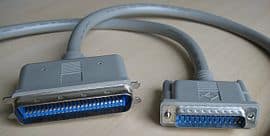

Small Computer System Interface (SCSI, skuz-ee) is a set of standards for physically connecting and transferring data between computers and peripheral devices. The SCSI standards define commands, protocols, electrical and opticalinterfaces. SCSI is most commonly used for hard disk drives and tape drives, but it can connect a wide range of other devices, including scanners and CD drives, although not all controllers can handle all devices. The SCSI standard defines command sets for specific peripheral device types; the presence of “unknown” as one of these types means that in theory it can be used as an interface to almost any device, but the standard is highly pragmatic and addressed toward commercial requirements.
**Source by wikipedia **
To Become Certified For CompTIA A+ Please Visit This Link ;


























